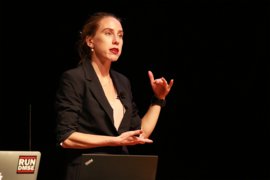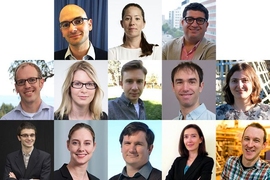Ensuring that her research contributes to society’s well-being is a major driving force for Jennifer Rupp.
“Even if my work is fundamental, I want to think about how it can be useful for society,” says Rupp, the Thomas Lord Assistant Professor of Materials Science and Engineering and an assistant professor in the Department of Electrical Engineering and Computer Science (EECS) at MIT.
Since joining the Department of Materials Science and Engineering in February 2017, she has been focusing not only on the basics of ceramics processing techniques but also on how to further develop those techniques to design new practical devices as well as materials with novel structures. Her current research applications range from battery-based storage for renewable energy, to energy-harvesting systems, to devices used to store data during computation.
Rupp first became intrigued with ceramics during her doctoral studies at ETH Zurich.
“I got particularly interested in how they can influence structures to gain certain functionalities and properties,” she says. During this time, she also became fascinated with how ceramics can contribute to the conversion and storage of energy. The need to transition to a low-carbon energy future motivates much of her work at MIT. “Climate change is happening,” she says. “Even though not everybody may agree on that, it’s a fact.”
One way to tackle the climate change problem is by capitalizing on solar energy. Sunshine falling on the Earth delivers roughly 170,000 terawatts per year — about 10,000 times the energy consumed annually worldwide. “So we have a lot of solar energy,” says Rupp. “The question is, how do we profit the most from it?”
To help convert that solar energy into a renewable fuel, her team is designing a ceramic material that can be used in a solar reactor in which incoming sunlight is controlled to create a heat cycle. During the temperature shifts, the ceramic material incorporates and releases oxygen. At the higher temperature, it loses oxygen; at the lower temperature, it regains the oxygen. When carbon dioxide and water are flushed into the solar reactor during this oxidation process, a split reaction occurs, yielding a combination of carbon monoxide and hydrogen known as syngas, which can be converted catalytically into ethanol, methanol, or other liquid fuels.
While the challenges are many, Rupp says she feels bolstered by the humanitarian ethos at MIT. “At MIT, there are scientists and engineers who care about social issues and try to contribute with science and their problem-solving skills to do more,” she says. “I think this is quite important. MIT gives you strong support to try out even very risky things.”
In addition to continuing her work on new materials, Rupp looks forward to exploring new concepts with her students. During the fall of 2017, she taught two recitation sections of 3.091 (Introduction to Solid State Chemistry), a class that has given thousands of MIT undergraduates a foundation in chemistry from an engineering perspective. This spring, she will begin teaching a new elective for graduate students on ceramics processing and engineering that will delve into making ceramic materials not only on the conventional large-scale level but also as nanofabricated structures and small-system structures for devices that can store and convert energy, compute information, or sense carbon dioxide or various environmental pollutants.
To further engage with students, Rupp has proposed an extracurricular club for them to develop materials science comic strips. The first iteration is available on Instagram (@materialcomics) and it depicts three heroes who jump into various structures to investigate their composition and, naturally, to have adventures. Rupp sees the comics as an exciting avenue to engage the nonscientific community as a whole and to illustrate the structures and compositions of various everyday materials.
“I think it is important to create interest in the topic of materials science across various ages and simply to enjoy the fun in it,” she says.
Rupp says MIT is proving to be a stimulating environment. “Everybody is really committed and open to being creative,” she says. “I think a scientist is not only a teacher or a student; a scientist is someone of any age, of any rank, someone who simply enjoys unlocking creativity to design new materials and devices.”
This article appears in the Autumn 2017 issue of Energy Futures, the magazine of the MIT Energy Initiative.









